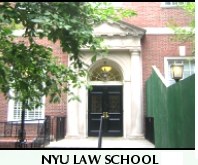The Application Process: How To Start Planning
 Published October 2006, last updated June 2010
Published October 2006, last updated June 2010
When applying to law school, one way to maximize your time and money, particularly when you put the law school application process in perspective, is to apply to eight or more. To put this course of action in context, you have probably spent several thousands of hours studying and attending classes during your four or five years in college. Additionally, you will likely have spent over 200 hours preparing for the LSAT.
In stark contrast, each additional application will only take you several hours to complete and require a nominal fee ranging from $50-$100. Given the variability of the student selection process, extra applications can possibly be the difference between your getting into a much better law school than you had originally anticipated. For example, one of my friends was rejected from the University of Texas Law School yet was accepted into Harvard Law School, a law school he almost did not apply to.
The following advice should help you increase your chances of admission to many law schools to which you should be applying.
Application Tips:
Law school admissions are generally on a rolling basis. Applying early may increase your chances of being admitted and at a minimum, early applications result in early notifications.
Ideally, law school applications should be completed by Halloween or, by the latest, Thanksgiving.
Carefully prepare your applications and law school personal statement, thereby ensuring that all responses are completely and concisely written and signed in all the appropriate places. Double check your applications before you submit them.
If you run out of room answering any question on the form, use a separate sheet of paper; be sure to put your name on it and indicate which question you are supplementing. It is a good idea to put your social security number on all of your materials to assist the admissions committee.
Keep track of all law school applications by having copies of all applications and correspondence related to those applications. Keep track of the dates the law school applications were sent and make sure you meet all deadlines.
Most law school applications have similar requirements including that you provide your LSAT scores, transcripts from all academic institutions that you have attended, letters of recommendation (generally two), law school personal statement, resume (often optional), and addendum (optional). Also, the LSDAS report is almost always required.
You may wish to send all important mail (this includes applications and a seat deposit after acceptance) via certified mail/return receipt requested (the cost is less than $5.00); this both alleviates anxiety and provides proof of mailing.
If you do not receive confirmation that your application has been received, call the law school admissions department to ensure that your file is complete.
Applicants may receive decision letters as early as November. Conversely, applicants who are wait-listed may receive a decision letter as late as early August.
Law School Application Timetable
It is in your best interest to apply as early as possible to law school. As the John Hopkins University pre-law handbook states, "even though stated application deadlines fall anywhere between January 1 and May 1, it is advisable to get your application completed and in by November 15 or earlier. This will insure a careful and thorough reading of it before admissions officers are faced with the thousands of applications that they have had to deal with in recent years. Many law schools have rolling admissions procedures, allowing those applicants who apply early a better opportunity; October 1 is not too early for competitive schools with rolling admissions. Earlier applicants also have an advantage when being considered for scholarship and grant opportunities."
New College (of Florida) states that "Many law schools use a rolling admission process, which means they evaluate applications and inform candidates of admission decisions on a continuous basis over several months, usually beginning in the fall and extending into mid-summer for candidates on a wait list. Due to rolling admissions, it is wise to apply as early as possible since the earlier you apply, the more spaces the law school will have available. In addition, the more acceptances or rejections you receive from law schools early on, the better you will be able to make decisions such as whether to apply to more law schools or whether to accept an offer."
The University of Florida Pre-Law Handbook states that "as soon as you come back to school for your senior year, you should get yourself organized for applying to law school. Make a list of all of the things which need to be completed for each application and a personal deadline for each of these items. You can increase your chances of acceptance by sending in your application as soon after October 1st as possible because your application may be compared with a fewer number of other applicants. Once applications are complete and sent into the law schools, it's time to sit back, relax and wait for their decisions."
The University of Notre Dame Prelaw provides the following advice: "You are responsible for making certain your letters of recommendation are sent in a timely fashion. Some applicants discover, even though they have filed their applications early, their files are delayed in the review process because the required letters of recommendation have not been received. This can seriously diminish their chances of acceptance, especially if they are already borderline."
Procrastinating will create a more hectic and stressful time for you and may cause you to make mistakes on your applications. While completing your law school applications is a timely and onerous process, taking care of everything early will both give you peace of mind and increase your chances of admission as well.
Next Section: The Waiting Game, Decisions, Deadlines, and the Wait-List
